The animal kingdom hosts an astonishing array of creatures, each possessing incredible strength and abilities. Some of these diverse species stand out for their sheer power and prowess. Exploring the strongest animals in the world is an intriguing journey through nature’s diverse habitats, as various factors such as size, environment, and different species’-specific adaptations contribute to their undeniable strength.
At the top of the list, elephants are widely recognized as the strongest land mammals, capable of carrying tremendous weight and showcasing immense physical power. Meanwhile, among birds, eagles are often considered the strongest, able to lift prey several times their own weight alone. These impressive creatures are not the only examples of extraordinary strength; other animals like gorillas, oxen, and insects like the dung beetle also possess impressive feats of force.
In this article, we delve into the fascinating world of these formidable animals, discussing their unique abilities, adaptations, and the factors that make them the strongest in their respective domains.
Strongest Animals in the World
1. The Grizzly Bear (Ursus Arctos Horribilis)
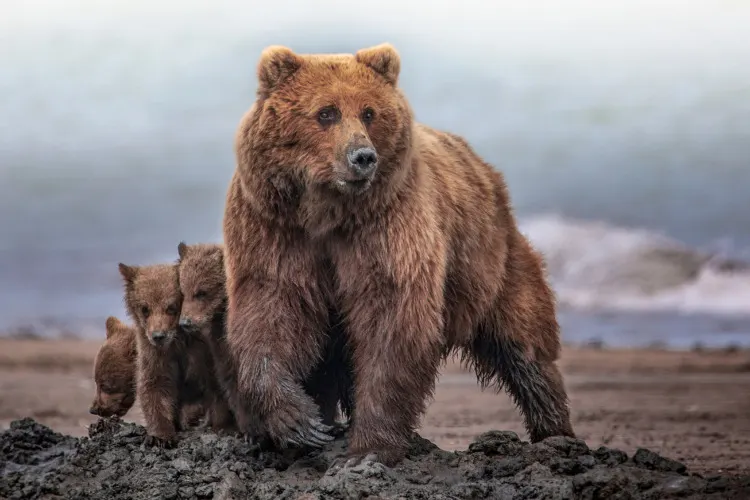
The grizzly bear, also known as the North American brown bear, is a subspecies of the brown bear (Ursus arctos) that inhabits parts of North America. As one of the strongest animals in the world, grizzly bears are known for their immense size, power, and adaptability.
Adult male grizzly bears can weigh between 400 to 700 pounds, while some have been reported to weigh over 1,500 pounds. Females are generally smaller, weighing between 250 to 450 pounds.
In terms of their strength, grizzly bears possess powerful shoulders and enormous claws, allowing them to swipe their paws with incredible force. One paw swipe from a grizzly bear is strong enough to break the spine of large mammals, making them formidable predators.
Grizzly bears‘ strength is not only limited to their physical power but also extends to their adaptability as predators in the wild. Although they reside at the top of the food chain, most of their diet consists of nuts, berries, fruits, leaves, and roots. However, grizzly bears are opportunistic predators known for their excellent fishing skills, preying on salmon during the spawning season. This ability to sustain itself on various food sources ensures survival in different ecosystems, including forests and mountainous regions.
Grizzly bears display their strength through their size, powerful paw swipes, and ability to adapt as predators. As one of the strongest animals in the world, they have earned their title and remain a fascinating subject of interest for those who study these awe-inspiring creatures.
See Related: Grizzly Bear vs Black Bear: What’s the Difference?
2. African Bush Elephant (Loxodonta Africana)
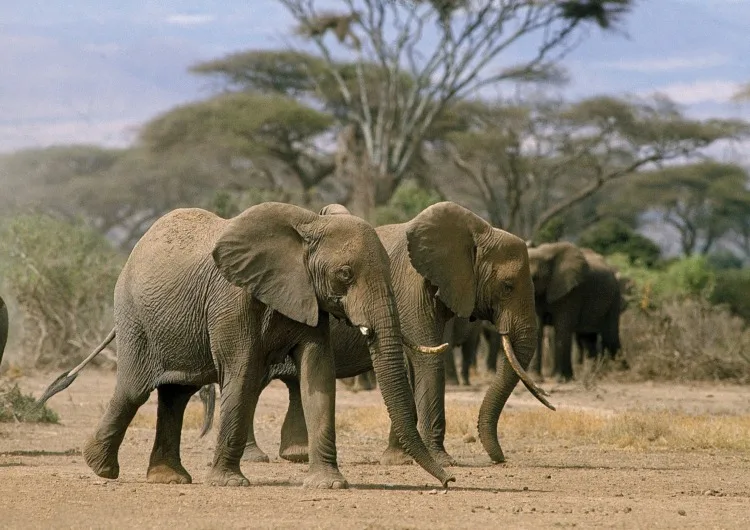
The African bush elephant (Loxodonta africana), also known as the African savanna elephant, is the largest land animal on Earth. With an adult male weighing up to 13,000 pounds and standing up to 13 feet tall, it stands as one of the strongest animals on the planet.
One of the key features contributing to the elephant’s immense strength is its powerful trunk. Composed of over 40,000 muscles, the trunk allows these remarkable animals to lift heavy objects, fight off predators, and gather food with incredible precision. The trunk is also highly sensitive, which enables the African bush elephant to detect vibrations in the ground – a crucial ability for locating water sources and communicating with other elephants.
In addition to its muscular trunk, the African bush elephant is equipped with robust jaws and strong tusks. The tusks are made of ivory and can grow up to 6.8 feet in length, making them formidable tools for defense and a primary reason for the African elephant’s poaching crisis. The massive jaws provide a powerful bite force, enabling these giants to consume vast amounts of vegetation daily.
The African bush elephant’s immense size and strength not only serve as a testament to its status as the largest land animal but also support its survival in the challenging landscapes of Africa. The power exhibited by this majestic beast allows it to easily navigate rugged terrain and overcome various obstacles in search of food, water, and mates.
These incredible attributes, coupled with the distinct social structure and complex behavior exhibited by the species, make the African bush elephant truly stand out as one of the strongest and most remarkable animals in the world.
See Related: Asian Elephant: Why Is It Endangered?
4. Horned Dung Beetle (Onthophagus Taurus)
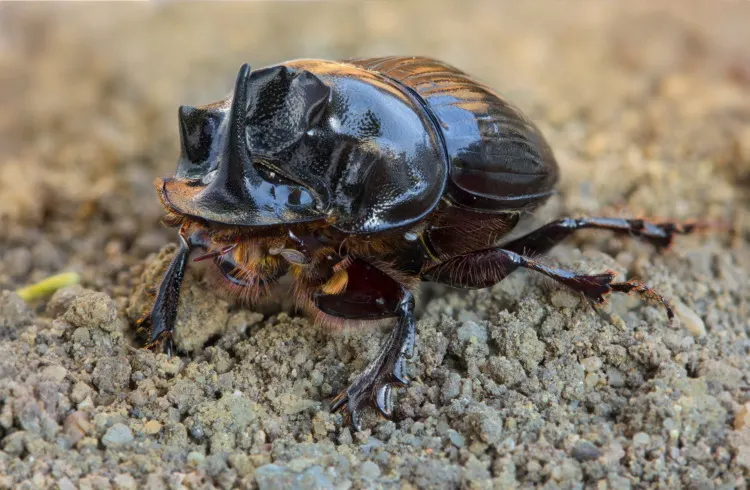
The Horned Dung Beetle, scientifically known as Onthophagus taurus, is a remarkable species in the world of insects. With an astonishing ability to pull 1,141 times its body weight, this beetle earns its title as the strongest insect in the world. This world record demonstrates the immense strength and resilience of the dung beetle in comparison to other animal species, including the once-considered world’s strongest insect, the rhinoceros beetle.
Distribution of this unique species varies greatly, spanning countries such as Australia, Europe, Morocco, Algeria, Tunisia, Syria, Iraq, Transcaucasia, Asia Minor, Iran, Afghanistan, Central Asia, and the United States (specifically Texas). This wide range of locations indicates the beetle’s ability to adapt to various environments.
The Horned Dung Beetle exhibits impressive interactions and communication behaviors among the males of the species. The males possess two distinctive body types: those with long horns and those without. Both variations have their own advantages within their community.
Horned dung beetles utilize their strength to battle other males in competition for female attention, while the hornless beetles rely on their agility to sneak around larger competitors, ultimately also achieving reproductive success.
In conclusion, the Onthophagus taurus, or Horned Dung Beetle, is an extraordinary example of physical strength and adaptability in the animal kingdom. Its world record in lifting weight relative to its own size sets it apart from other insects and provides a testament to the wonders of nature.
See Related: Difference Between African and Asian Elephants: A Comprehensive Comparison
5. Rhinoceros Beetle (Dynastinae)
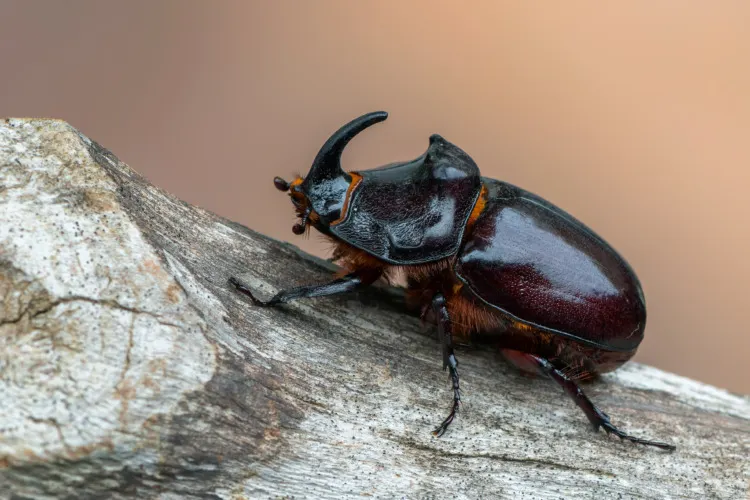
Rhinoceros beetles, belonging to the subfamily Dynastinae, are among the strongest animals in the world. These herbivorous insects have horn-like projections on and around the males’ heads, contributing to their rhinoceros-like appearance. Most rhinoceros beetles are black, gray, or greenish in color, and some even have a covering of soft hairs.
These beetles display impressive strength that has long intrigued researchers. Studies have shown that rhinoceros beetles can support an astonishing 850 times their own body weight. To put this into perspective, this is equivalent to a very average human being being capable of lifting nine adult male elephants.
The Dynastinae subfamily is home to more than 1,500 species of rhinoceros beetles, with varying populations spread across every continent, except Antarctica. These beetles typically inhabit forested areas, found in decaying logs and leaves.
One of the largest and most well-known rhinoceros beetles is the Hercules beetle, which can grow up to 7 inches (17 centimeters) in length. Despite their intimidating size and strength, these beetles pose no threat to humans as they are not equipped to bite or sting.
Rhinoceros beetles are remarkable creatures that exhibit incredible strength. Not only are they fascinating testaments to the diversity of nature, but they also serve as a prime example of the incredible capabilities within the animal kingdom.
See Related: Are Insects Animals? Exploring the Truth
6. Tigers (Panthera Tigris)
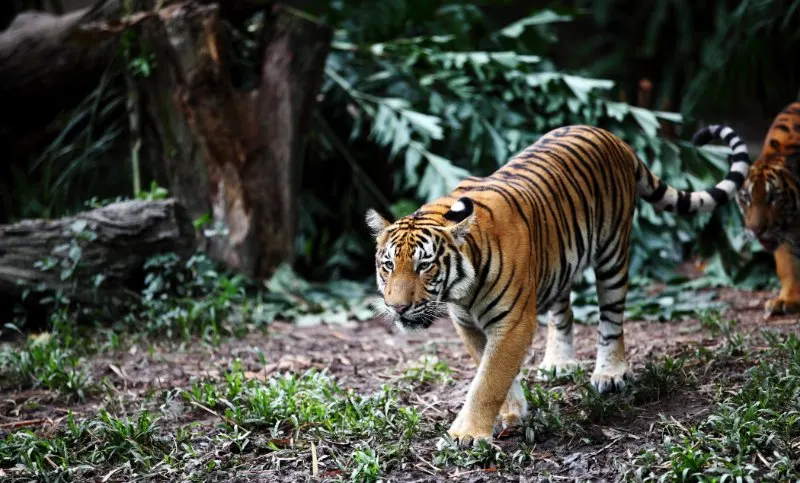
Tigers are one of the strongest animals in the world and are highly effective hunters within their ecosystems. As the largest members of the big cat family, the size of an adult tiger can range from 6 to 10 feet in length and weigh between 220 to 660 pounds, depending on the subspecies. Their muscular bodies give them immense power, enabling them to take down large prey with precision and force.
The Siberian tiger stands out as the strongest and largest of the tiger species. This powerful feline, found in Eastern Russia, China, and North Korea, can reach top speeds of up to 50 mph while pursuing prey. Though often confused for the Bengal tiger, the Siberian tiger is slightly larger and would likely emerge as the victor if these two subspecies ever faced off.
Different subspecies of tigers have adapted to various habitats across Asia, including:
- Tropical rainforests
- Evergreen forests
- Temperate forests
- Mangrove swamps
- Grasslands
- Savannahs
As apex predators, tigers are essential for maintaining balance within their habitats. They primarily hunt large ungulates such as deer, cattle, and wild boars, exhibiting incredible stealth and agility to ambush their prey. In addition to their physical traits, these big cats are equipped with powerful jaws and sharp claws, making them formidable predators.
Tigers face several challenges: habitat loss, poaching, and human-wildlife conflict. Their population has dwindled to approximately 4,500, earning them an endangered conservation status. Efforts to protect and conserve these magnificent animals are crucial not only for the species’ survival, but also for preserving the health and balance of their ecosystems.
See Related: Fastest Animals in the World
7. Harpy Eagle (Harpia Harpyja)
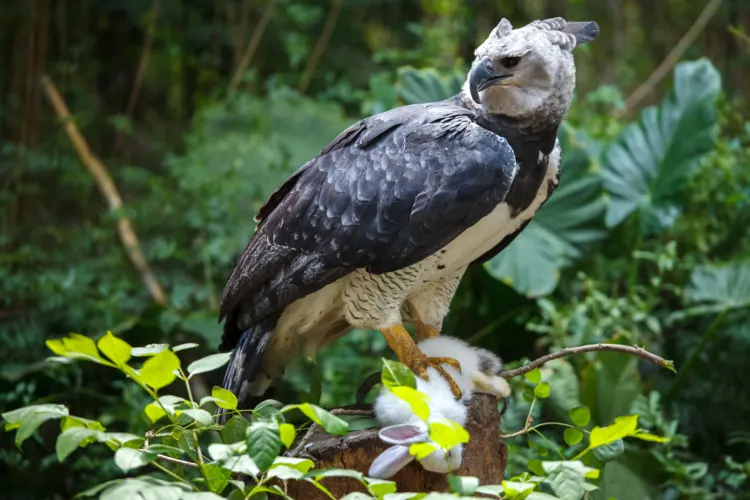
The harpy eagle (Harpia harpyja) is a neotropical species of eagle found in Central and South America’s rainforests. This powerful bird of prey is the largest and most formidable raptor in these regions and ranks among the world’s largest eagle species.
Known for its impressive size and strength, the harpy eagle’s wingspan can reach up to 7.5 feet (2.3 meters) and the bird can weigh up to 20 pounds (9 kilograms). The female harpy eagles are typically larger and stronger than their male counterparts, exhibiting sexual dimorphism in size and dominance.
One key characteristic that contributes to the harpy eagle’s status as the strongest bird in its habitat is its sharp talons. These talons can grow up to 5 inches (13 centimeters) long, which is roughly the same length as a grizzly bear’s claws. This remarkable adaptation allows the harpy eagle to grasp and carry prey that can weigh up to half of its body weight, such as sloths and monkeys.
As a bird of prey, the harpy eagle is an apex predator in its ecosystem, with no natural predators other than humans. Its powerful build, large talons, and excellent vision make it extremely effective at capturing prey and maintaining its place at the top of the food chain. However, this powerful bird is currently facing challenges due to habitat destruction, primarily caused by deforestation, leading to a near-threatened conservation status.
The harpy eagle (Harpia harpyja) is an awe-inspiring embodiment of strength, size, and predatory prowess. Its sharp talons and impressive physical attributes dominate its habitat as the strongest bird of prey in the rainforests of Central and South America.
See Related: Philippine Eagle: Species Overview, Conservation and Threats
8. Saltwater Crocodile (Crocodylus Porosus)
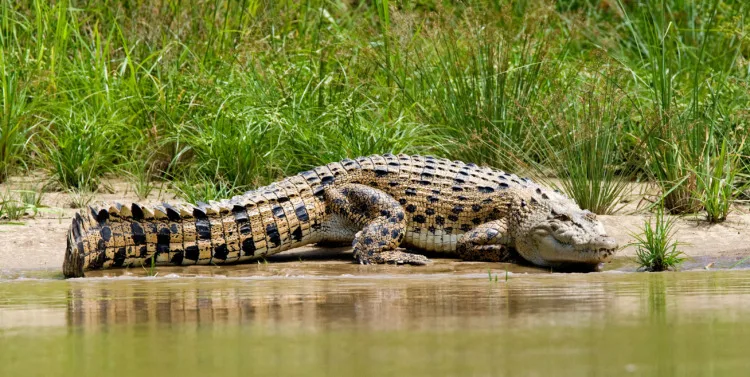
The Saltwater Crocodile, or Crocodylus Porosus, is among the strongest animals in the world. It is known for its immense size and powerful bite.
As Earth’s largest living crocodilian, it is a formidable predator and can be found mainly in coastal waters or around rivers. It exhibits a high tolerance for salinity and may also inhabit freshwater rivers, billabongs, and swamps.
Adult male saltwater crocodiles can reach lengths of up to 23 feet and weigh as much as 2,000 pounds, making them the largest reptiles in the world. Females are generally smaller, growing up to 10 feet in length and weighing around 330 pounds. Strength and size together contribute to their top position in the food chain, dominating their habitats and consuming a variety of prey including fish, birds, and mammals.
The defining feature of the saltwater crocodile is its jaw, which boasts the most powerful bite force of any living animal. Measuring at a staggering 3,700 pounds per square inch (psi) of pressure, its bite is approximately three times more powerful than the bite of a lion. When combined with their sharp teeth, this immense force enables them to efficiently capture and dismantle their prey.
Saltwater crocodiles use their incredible strength to hunt efficiently. They are stealthy ambush predators, lurking just beneath the water’s surface and using their camouflaged appearance to blend in with the surroundings.
Despite their massive size, they are extremely agile in the water and can achieve surprising speeds. This makes it easy for them to strike their prey precisely, using their strong jaws to clamp down and drag the victim into the water.
Tthe Saltwater Crocodile is a prime example of one of the strongest animals in the world. Its impressive size, considerable strength, and powerful bite force make it a highly effective predator in its natural habitat.
See Related: These Are 16 of the Strongest Animals in the World
9. Gorilla (Gorilla)
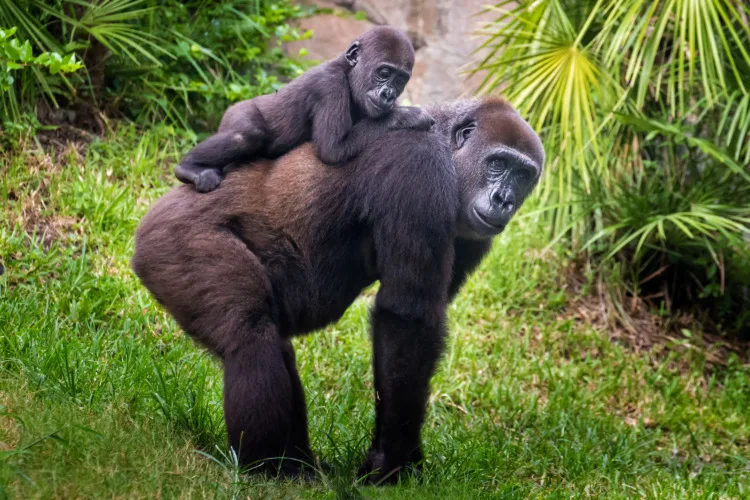
Gorillas are the largest and strongest primates, often regarded as gentle giants. They can reach a height of 4 to 6 feet and weigh up to 440 pounds. Their intimidating size and strength are crucial in their survival and social interactions.
Their powerful muscles enable them to provide astounding displays of pure brute strength. For example, their bite force is one of the strongest of any animal, measuring about 1,300 pounds per square inch. This strong bite is essential for their predominantly herbivorous diet, which consists of leaves, fruit, and flowers found in the rainforests and dense jungles of Africa.
Gorilla’s arms are incredibly powerful animals robust, allowing them to move efficiently on all fours using knuckle-walking. Although their punch strength remains unknown, it is speculated that they can deliver a force between 1,300 to 2,700 pounds—enough to shatter a human skull.
Despite their impressive power, gorillas are not aggressive by nature. They possess a complex social hierarchy, relying on displays and postures rather than physical confrontations to maintain order. Males often beat their chests to showcase their strength and deter potential rivals or threats.
Natural predators of gorillas are scarce, with the primary threat being humans. Gorillas are considered a Near Threatened species due to habitat loss, poaching, and disease. Conservation efforts are crucial to ensure the survival of the world’s strongest primate.
See Related: Difference Between African and Asian Elephants: A Comprehensive Comparison
10. White Rhinoceros (Ceratotherium Simum)
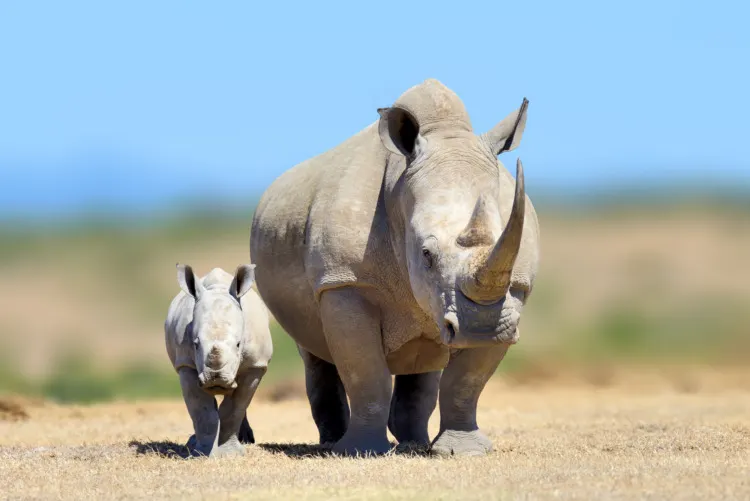
The white rhinoceros, scientifically known as Ceratotherium simum, is one of the largest and most powerful terrestrial animals on Earth. Native to Africa, they inhabit grasslands, savannas, and woodlands near water sources, where they consume grass to maintain their enormous size. They are 5-6 feet tall and weigh between 3,080-7,920 pounds. Their immense size makes them a prime example of strength within the animal kingdom.
Their muscle mass and physical attributes enable the white rhinoceros to be considered one of the strongest animals in the world. The animal’s robust limbs efficiently support its massive weight, with well-developed shoulders adding to its overall power.
This sheer strength is highlighted in their ability to uproot trees or effortlessly bulldoze through dense vegetation. Predators struggle to challenge the white rhinoceros, as few animals can match their endurance and raw force.
One characteristic that makes the white rhinoceros an undeniable testament to strength is its impressive charge. When provoked or threatened, these mighty animals can reach speeds of up to 31 mph. This agility, combined with their enormous size and horn, can inflict severe damage on potential threats or obstacles in its path.
The white rhinoceros showcases its remarkable strength through its massive size, robust limbs, and powerful charge. As one of the largest and most commanding animals on the planet, the white rhinoceros more than earns its place among the world’s strongest creatures.
See Related: Black Rhino: Why Is It Endangered?
11. Jaguar (Panthera Onca)
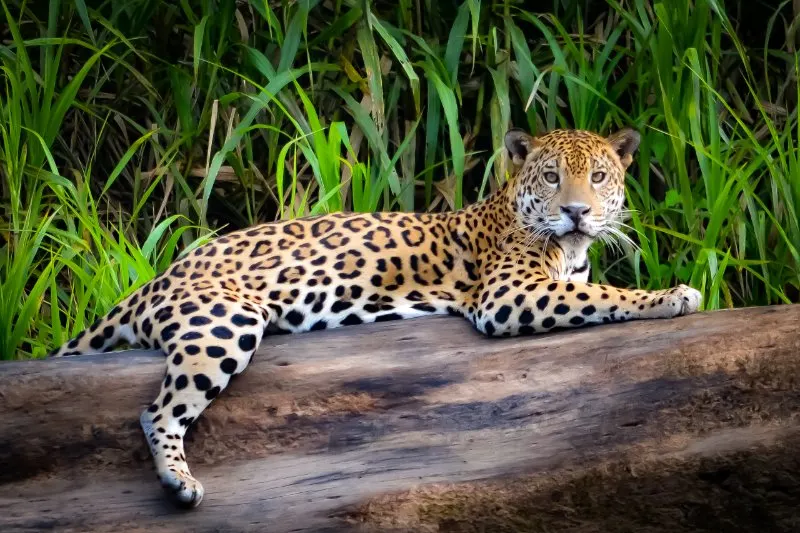
The jaguar (Panthera onca) is a large cat native to Central and South America and is known for its incredible strength and agility. They are generally found in forests, grasslands, swamps, and scrublands. Jaguars are the third-largest felines globally, with an average length of 5-6 feet and a weight of 100-250 pounds.
Jaguars possess incredible strength, which is showcased in their robust body structure and muscular limbs. Their stocky legs and short, round ears make them easily recognizable. These mighty cats have the strongest bite force among all felines, with a powerful bite strength twice as strong as a lion’s.
Jaguars are solitary and extremely skilled predators, engaging in ambush hunting tactics. They primarily prey on deer, capybara, and tapir, but are known to hunt and consume more than 85 species. Their excellent swimming ability allows them to target aquatic prey such large animals such as turtles and caiman as well.
Jaguars’ powerful jaws enable them to kill their prey by piercing the skull with their sharp teeth, delivering a single fatal bite. This bite strength is advantageous for capturing and carrying heavy prey across long distances, demonstrating the jaguar’s incredible power and resilience.
Although jaguars are typically not aggressive towards humans, human-jaguar conflicts can occur when their natural habitat is encroached upon or destroyed. Deforestation, fragmentation, and poaching are significant threats to the jaguar population. Consequently, the species is currently classified as near threatened.
The jaguar (Panthera onca) is an impressively strong and adaptable feline, exhibiting remarkable power through its muscular physique and unparalleled bite force. As top predators in their ecosystems, they play a crucial role in maintaining a balanced and healthy environment. Protecting their habitats and conserving their populations are essential for maintaining the natural balance and preserving the jaguar’s exceptional strength and prowess.
See Related: Fastest Animals in the World
12. Hippopotamus (Hippopotamus Amphibius)
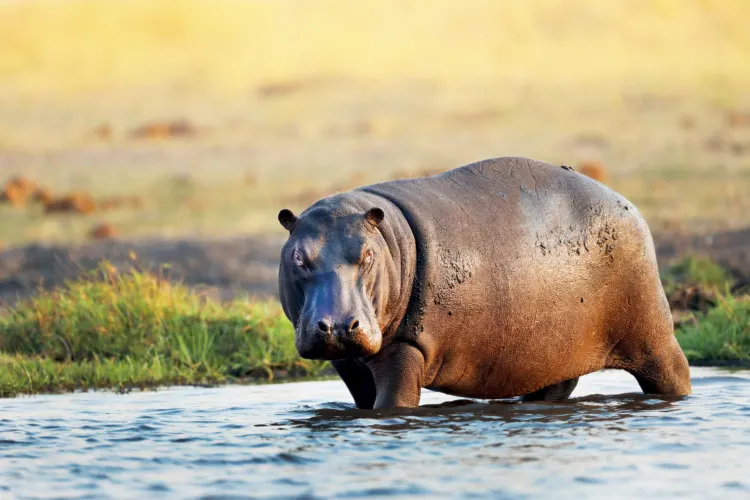
The hippopotamus, or the common or river hippo, belongs to the animal kingdom’s order of Artiodactyla and the family Hippopotamidae. These bulky animals possess tremendous strength and are considered among the strongest animals in the world, often weighing around 3,200 kg (3.5 tons) for males. Their physical size and strength enable them to maintain a prominent position in their natural habitat while protecting themselves and their territories from potential predators.
Their distinct strength can be attributed to many factors, including an incredibly powerful bite force. With a jaw equipped with large and sharp teeth, hippos are known to have one of the strongest bites in the animal kingdom, surpassing even the lion. Hippo’s bite force can reach up to 2,000 pounds per square inch (PSI), much greater than a lion’s roar, which measures at approximately 1,000 PSI.
Hippos primarily derive energy and strength from their plant-based diet: grasses, grains, and flowers. Despite their massive size, they exhibit great agility on land and in water. In water, the hippos can hold their breath for up to five minutes, allowing them to remain submerged and hide in their surroundings.
On land, they can reach up to 30 kilometers (19 miles) per hour. This combination of strength and speed contributes to their status as one of the strongest animals globally.
In conclusion, the hippopotamus is a prime example of strength and power in the animal kingdom. With its impressive bite force, large size, and agility in both land and water, the hippo solidifies its position among the world’s strongest animals.
13. Oxen (Bos Taurus)
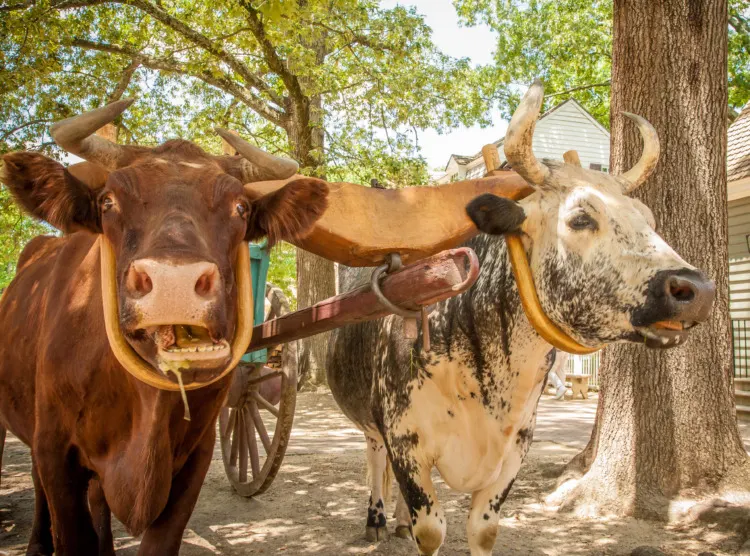
Oxen are among the strongest and most versatile domesticated animals on Earth. As members of the Bos Taurus species, these large, horned mammals have been used for centuries for their impressive strength and endurance. Originally native to northern Africa, Europe, and southern Asia, oxen are now found throughout much of the world, including North and Central America.
One key aspect of oxen strength lies in their sheer physical size. They can weigh up to 1,800 pounds, making them one of the largest land animals used for labor. Their powerful bodies enable them to carry on tasks such as plowing fields, hauling heavy loads, and providing reliable transportation.
Another reason oxen are considered among the strongest animals is their ability to work in teams. When yoked together, a pair of oxen can increase their pulling power significantly.
This cooperative behavior allows oxen to accomplish impossible tasks for a single animal. In addition, oxen have a calm and steady temperament, which adds to their efficacy and reliability as working animals.
Some notable features of oxen that contribute to their strength include:
- Thick neck muscles: A well-developed muscular structure supports the weight of their massive heads and horns, as well as the yoke when working.
- Dense bones: Their heavy skeletons support their muscular systems, enabling them to carry considerable weight.
- Strong limbs: Oxen possess sturdy legs with strong hooves, which allow them to navigate various terrains with ease and maintain traction in challenging conditions.
The combination of physical attributes, cooperative behavior, and adaptability makes oxen some of the strongest and most impressive animals in the world. Their longstanding relationship with human civilizations showcases their remarkable capacity for labor, endurance, and resilience.
See Related: How Do Animals Adapt To Their Environment?
14. Leafcutter Ants (Tribe Attini)
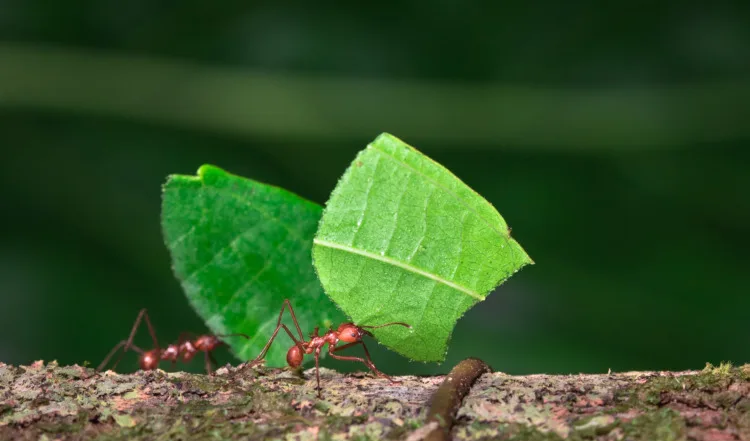
Leafcutter ants, belonging to the tribe Attini, are a group of 39 species of ants native to the American tropics. Often seen in their characteristic foraging columns, these ants carry small pieces of leaves, with trails of cut foliage extending over 30 meters (100 feet) across the forest floor and up and down the trunks of canopy trees.
Regarding size, leafcutter ants vary, with workers ranging from 2 to 20 millimeters in length. Despite their small size, these insects boast remarkable strength, carrying up to 50 times their body weight. To put this into perspective, humans with the same body mass and proportional strength could carry a minivan using only their mouth.
In the animal kingdom, leafcutter ants are known for their highly organized and efficient societies. They practice agriculture by cultivating fungi from the leaves they collect, engaging in an ancient mutualism with the coevolved fungi from the order Agaricales. This remarkable farming technique predates human agriculture and is shared among the entire tribe of Attini ants.
Leafcutter ants are a prime example of the incredible strength and unique agricultural behaviors in the insect world. They exemplify the fascinating capabilities of the animal kingdom, showcasing their advanced techniques, cooperation, and adaptability within their complex societies.
See Related: 35 Different Types of Eagles in the World
15. Honey Badger (Mellivora Capensis)
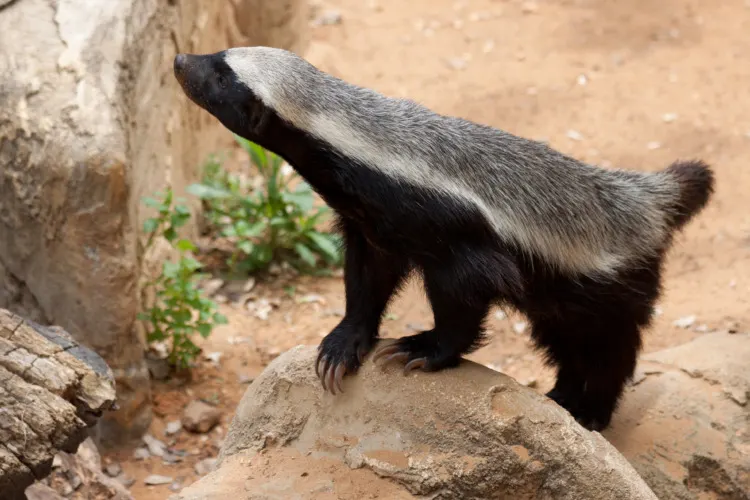
The Honey Badger, scientifically known as Mellivora capensis, is a small carnivore known for its tenacity and fearlessness. Despite its size, it has gained a reputation for being one of the toughest animals in Africa, due to its impressive strength, ferocious defensive abilities, and near-impervious skin.
These fearless creatures belong to the order Carnivora and the family Mustelidae. Honey Badgers can be found in a variety of covered and forested regions across Africa and southern Asia. They are opportunistic feeders, consuming various prey, including bees, insects, small animals, bulbs, roots, and bird eggs.
Honey Badgers have few natural predators due to their remarkable defensive behavior and physical characteristics. Their thick skin protects them from bee stings, bites, and other forms of attack, while their strength enables them to fend off larger foes. As a result, they are listed as the “most fearless animal in the world” in the Guinness Book of World Records (2002 Edition).
Some notable facts about the Honey Badger include:
- Scientific Name: Mellivora capensis
- Family: Mustelidae
- Distribution: Africa and southern Asia
- Conservation Status: Least Concern
In summary, the Honey Badger is a small yet formidable creature with impressive strength, making it one of the strongest animals in the world. Its resilience, adaptability, and fearless nature allow it to thrive across a wide range of habitats and without many natural predators.
16. Green Anaconda (Eunectes Murinus)
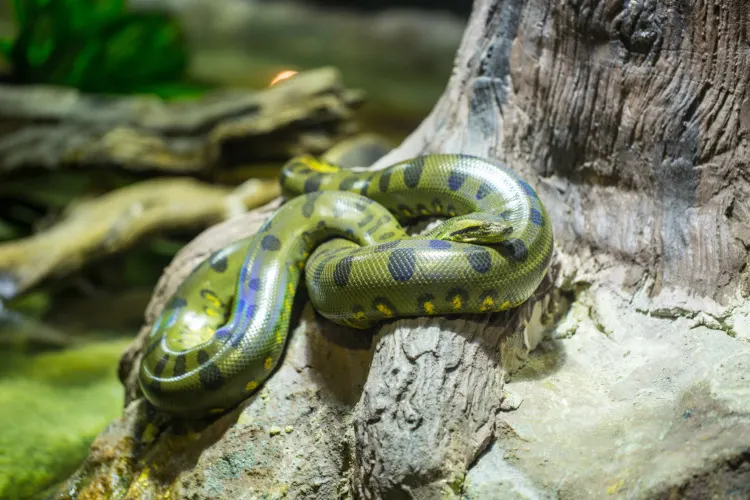
The green anaconda, scientifically known as Eunectes murinus, is a remarkable species in the animal kingdom. As a member of the boa family, it holds the title of the world’s heaviest snake, with a weight of up to 200 kilograms and a length of up to 5.21 meters (17 ft 1 in). Its sheer size and power place it among the largest and strongest animals on the planet.
This massive snake is native to the tropical lowlands of South America, commonly found in the Orinoco basin of eastern Colombia, the Amazon River basin of Brazil, and the seasonally flooded Llanos grasslands of Venezuela. As a predator, the green anaconda’s strength lies in its ability to constrict its prey using its strong body.
When it comes to hunting, the green anaconda employs a stealthy approach, lurking underwater and using its excellent camouflage ability to blend into its surroundings. Once it senses its prey nearby, the anaconda strikes with lightning speed, using its formidable jaw strength to latch onto the target. It then wraps its muscular body around the prey, coiling tighter with each breath the victim takes, eventually suffocating it.
The green anaconda’s diet largely consists of mammals, birds, and other reptiles. In a few rare cases, they will eat prey and have been known to take down large prey such as jaguars. Although attacks on humans are not common, the strength and size of this giant snake put it on the list of nature’s most powerful predators.
In conclusion, the green anaconda is a true testament to the incredible strength and adaptability present in the animal kingdom. With its immense size, constricting abilities, and formidable hunting techniques, the green anaconda rightfully earns its reputation as one of the strongest and most captivating species in the snake world.
Frequently Asked Questions
What are the top 10 strongest land animals?
The top 10 strongest land animals include the elephant, grizzly bear, anaconda, and gorilla. Elephants are known for their brute strength, being able to uproot trees and lift enormous weights of over 500 kg.
Grizzly bears have a powerful lifting capability, going up to 700 pounds. Anacondas can squeeze their prey with a force equal to their 250 kg body weight, while gorillas have immense muscular power.
Which animal has the most powerful bite?
The saltwater crocodile possesses the most powerful bite among all animals. With a bite force of around 3,700 pounds per square inch (PSI), it far surpasses other animals such as the great white shark, grizzly bear, and lion.
What is the toughest animal to fight against?
The toughness of an animal varies based on physical strength, resilience, and aggression. However, a grizzly bear is often considered one of the toughest animals to fight due to its size, strength, and ferocity. Other formidable opponents could be large predators like the lion or crocodile.
Which mammal is the strongest in the world?
Elephants are regarded as the strongest mammals and land animals in the world. They possess unmatched power to lift and carry heavy objects, thanks to their immense size and incredibly strong back muscles.
What animal is considered pound for pound the strongest?
The African dung beetle is considered pound-for-pound the world’s strongest animal. It can lift and move objects up to 1,141 times its own body weight, a feat unmatched by any other creature on the planet.
What is the hardest hitting animal on earth?
The mantis shrimp holds the title of the hardest-hitting animal on earth. It can deliver a punch with a force of over 330 pounds and an acceleration of 10,400g, making it an incredibly powerful and fast striker. This colossal force allows them to break through shellfish and prey upon other small marine creatures.
Related Resources
- Five-Letter Animals to Know Around the World
- Fastest Animals in the World
- Why Were Animals So Big in the Past?


